| Coat of arms of Thuringia | |
|---|---|
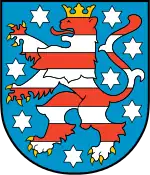 | |
| Armiger | Free State of Thuringia |
| Adopted | 1990 |
| Blazon | Azure, a lion rampant barry of eight Gules and Argent, crowned and armed Or, surrounded by eight mullets Argent |
The coat of arms of the German state of Thuringia was introduced in 1990. Like the 1949 coat of arms of Hesse it is based on the Ludovingian lion barry, also known as the "lion of Hesse", with the addition of eight mullets.
Description
The coat of arms can be blazoned Azure, a lion rampant barry of eight Gules and Argent, crowned and armed Or, surrounded by eight mullets Argent.[1] This can be interpreted as a blue field with a lion of eight horizontal red-and-white-stripes, with a gold crown and claws, with eight white/silver stars. Some people believe the stars represent eight historical divisions of the state.[1]
Legal position
It was included in the Gesetz über die Hoheitszeichen (Law on the Regional Emblems) of 30 January 1991,[2] which came into law retrospectively to 3 October 1990.[2] The current law, Verordnung zur Ausführung des Gesetzes über die Hoheitszeichen des Landes prescribed its use, including banning use by third parties,[3] use of the coat of arms on the seal[3] and use of the arms on the State flag.[3]
History
Gallery
 Schwarzburg-Sondershausen 1599-1918
Schwarzburg-Sondershausen 1599-1918 Schwarzburg-Rudolstadt 1599–1918
Schwarzburg-Rudolstadt 1599–1918 Duchy of Saxe-Altenburg 1602–1672 and 1826-1918
Duchy of Saxe-Altenburg 1602–1672 and 1826-1918 Duchy of Saxe-Meiningen 1680–1918
Duchy of Saxe-Meiningen 1680–1918 Duchy of Saxe-Gotha-Altenburg 1672–1826
Duchy of Saxe-Gotha-Altenburg 1672–1826 Duchy of Saxe-Hildburghausen 1680–1826
Duchy of Saxe-Hildburghausen 1680–1826 Principality of Reuss-Greiz 1778–1918
Principality of Reuss-Greiz 1778–1918 Principality of Reuss-Gera 1806–1918
Principality of Reuss-Gera 1806–1918 Saxe-Weimar-Eisenach 1809–1918
Saxe-Weimar-Eisenach 1809–1918 Saxe-Coburg and Gotha 1826–1918
Saxe-Coburg and Gotha 1826–1918 People's State of Reuss 1919–1920
People's State of Reuss 1919–1920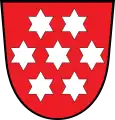 Free State of Thuringia 1921-1933
Free State of Thuringia 1921-1933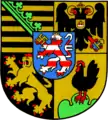 Free State of Thuringia 1933-1945
Free State of Thuringia 1933-1945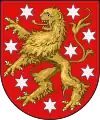 Coat of arms of Thuringia 1945–1952
Coat of arms of Thuringia 1945–1952
State of Thuringia (1920 - 1933)
The state of Thuringia was created in 1920 by uniting the seven Thuringian polities: Saxe-Weimar-Eisenach, Saxe-Meiningen, half of Saxe-Coburg and Gotha (where Saxe (Gotha) subsequently merged into Thuringia whereas Coburg merged into Bavaria), Saxe-Altenburg, Republic of Reuss (Reuss Elder Line, Reuss Younger Line), Schwarzburg-Sondershausen and Schwarzburg-Rudolstadt. The northern part of today's Thuringia was part of Prussia (Erfurt governorate) and therefore not represented in this coat of arms. Inspired by the American flag (by featuring one star for each of its counties), the shield is gules, seven mullets of six points argent - seven six-pointed stars on a red background.[4] It was used on the state flag of that period.[4] The coat of arms was used until 1933, when the NSDAP government created a new coat of arms.
Landgraves of Thuringia
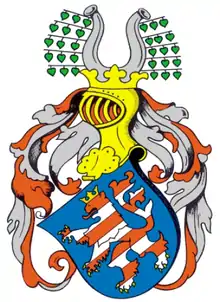
In 1040 the Ludovingians, a dynasty from Upper Franconia (then Upper East Franconia), became the rulers of territories northern Thuringia, which at that time were part of the duchy of Saxony. Later generations of the house gained control of more of Thuringia and parts of West Franconia around Hessengau (today northern Hesse) and became counts palatine of Saxony. In 1137 they became landgraves, a position comparable to that of a duke and which was imperially immediate (i.e. they were subject only to the emperor and not to any intermediate feudal lord). In 1247 the Ludowinger line died out and they were succeeded by the Saxon House of Wettin. In 1264 the eastern parts of the landgraviate, which lay in modern Thuringia, were united with the Margraviate of Meissen following the War of the Thuringian Succession. (The western parts became the Landgraviate of Hesse. The Hessian landgraves retained the Thuringian lion barry, and its use continued through the various Hessian states to this day, where it can be found in the coat of arms of the modern state Hesse, albeit in a slightly different form than modern Thuringia's.)
The arms, used by Landgrave Conrad in the 13th century, were azure, a crowned lion rampant barry of eight argent and gules, crown and claws or.
References
- 1 2 "Thuringia (Germany) - Coat of arms". Flags of the World. 7 Oct 2001. Retrieved 2009-04-26.
- 1 2 Gesetz über die Hoheitszeichen des Landes Thüringen Archived 2009-11-03 at the Wayback Machine (Law on the regional emblems of the Land of Thuringia). Accessed 2009-04-26. (in German)
- 1 2 3 Verordnung zur Ausführung des Gesetzes über die Hoheitszeichen des Landes Archived 2011-07-19 at the Wayback Machine (Regulation for the implementation of the law on the regional emblem of the state). Accessed 2009-04-26. (in German)
- 1 2 State of Thuringia at Flags of the World Accessed 2009-05-16.
See also
- Coat of arms of Prussia
- Coat of arms of Germany
- Coat of arms of Hesse, which has a similar appearance.
- Origin of the coats of arms of German federal states.